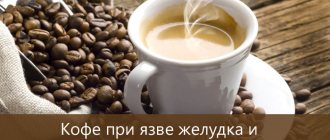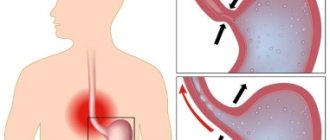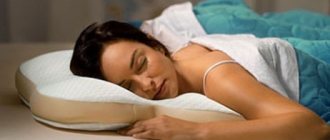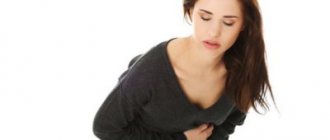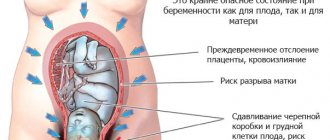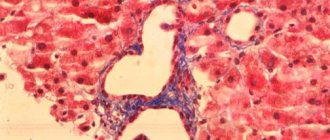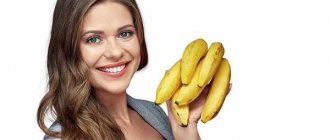Gastritis
27.01.2017
Greetings, readers. Poor and irregular nutrition can cause serious problems in the functioning of the stomach. The most dangerous situation is when bile accumulates in the stomach. Diet is the only way out of the situation, as it allows you to reduce the negative impact of intestinal contents on the mucous membrane in a short period of time.
- Main warning symptoms
- Bile in the stomach - diet
- Diet for bile stagnation - basic principles of culinary food processing
- What's not allowed?
- Approximate menu for the day
- Useful tips
Only by adhering to a special diet can serious complications be prevented. If you do not adhere to the diet, reflux can develop into chronic inflammation of the gastric mucosa, namely gastritis.
General rules
An urgent medical problem is disorders of the motor function of the digestive tract. Due to impaired motor skills, the following symptoms are common: belching , heartburn , bitterness, nausea, loss of appetite, bloating or heaviness in the epigastrium.
They can be functional in nature or secondary, arising against the background of organic diseases. Motor activity of the stomach begins from the moment a bolus of food passes through the lower esophageal sphincter. The body and fundus of the stomach deposit and mix food, and the pylorus evacuates portions into the duodenum. The so-called antral systole is a strong contraction of the antrum of the stomach towards the small intestine, which plays a major role in moving food into the duodenum.
Food comes here in small portions. The pylorus periodically opens, and the gastric wave pushes the contents into the duodenal bulb. The pressure difference contributes to this - the pressure in the stomach is higher. The intake of food portions, in turn, activates the peristalsis of the duodenum and the release of bile from the gallbladder. In this initial section of the small intestine, chyme mixes with bile and pancreatic juice, and thanks to peristaltic contractions it moves further. This is what normal upper gastrointestinal motility looks like.
Duodenogastric reflux (DGR) is the backflow of duodenal contents into the stomach. Clinically manifested by discomfort and epigastric pain, belching of air, bitterness in the mouth, regurgitation, heartburn and vomiting of bile. There may be alternation of diarrhea with constipation . In its development, a major role is played by a decrease in the tone of the stomach and pylorus (impaired its closing function) in combination with increased activity of the duodenum and increased pressure in it. A common cause of motor disorders is a violation of nervous regulation against the background of mental disorders.
In addition to the unpleasant symptoms for the patient, under the influence of bile acids in the stomach, a restructuring of the mucous membrane occurs, changes in gastric mucus and inflammatory changes occur. Against the background of GHD, and of any severity, signs of gastritis in the antrum, and even erosive changes, are found. The main damaging factors in this case are not only bile acids thrown into the stomach, but also lysolecithin and pancreatic enzymes.
Treatment of this condition consists of prescribing motility regulators ( Itomed , Trimedat ), mucocytoprotectors (they protect the gastric mucosa from the adverse effects of bile: De-nol and other bismuth preparations). De-Nol is also capable of binding bile acids.
The basic drug is Ursosan - it compensates for the lack of bile acids in the intestines, transfers the synthesis of toxic bile acids to the production of non-toxic compounds. It is prescribed at a dose of 250 mg at night for 3 months in a row.
Diet therapy is considered an important component of treatment. The diet for the reflux of bile into the stomach includes:
- Refusal of heavy foods (fried meat, sausages, smoked meat with cartilage and excessively stringy meat, poultry and fish skin).
- Limiting fats, which are difficult and take a long time to digest and slow down peristalsis.
- Avoid carbohydrate-containing drinks and cold drinks. You can drink still water 30 minutes before meals or between meals. After eating, you should not indulge in drinking tea or drinking large amounts of water.
- Significant limitation of legumes and foods that cause bloating (kvass, carbonated drinks, fresh yeast baked goods, grapes, raisins, fresh apples in large quantities).
- Elimination of foods that irritate the mucous membrane: fried, spicy, fatty.
- Avoid alcohol, limit strong tea and coffee.
- Include fiber in the diet through vegetables and fruits, but they must be thermally processed. At the same time, the consumption of vegetables rich in fiber (turnips, radishes, asparagus, radishes, legumes) and fruits with rough peels (grapes, dates, gooseberries, currants) is limited.
- It is undesirable to eat bread made from wholemeal flour and coarse cereals (millet, pearl barley, barley, corn).
- Eat 6 split meals a day, follow a diet, avoid overeating during the day and especially at night.
It is believed that duodenogastric reflux worsens at night. The diet should be designed so that higher-calorie foods are included in the first half of the day, and dinner is light. Eating food should be leisurely and chewed thoroughly.
The basis of the diet should be boiled, low-fat and easily digestible foods: porridge, light soups, boiled fish and chicken (baking without a rough crust is allowed), boiled vegetables or vegetable purees, jelly (oatmeal or any fruit - they have an enveloping effect).
The most suitable option for feeding the patient is Table No. 1 . This diet helps to normalize the motor-evacuation and secretory functions of the stomach and duodenum. Contains 100 g of proteins, no more than 90 g of fat and 400 g of carbohydrates with a calorie content of up to 2700 kcal. Salt should be limited to 6 g per day.
Patients with this pathology need to avoid physical activity after eating, bending, lifting heavy objects - anything that can cause an increase in intra-abdominal pressure. It is also important to prevent constipation and flatulence .
Main warning symptoms
Of course, with such problems, a visit to the doctor is mandatory, but before the patient gets an appointment, he may notice some important symptoms indicating bile entering the stomach, namely:
- severe nausea;
- unpleasant bitter taste in the mouth;
- frequent belching after eating;
- partial or complete loss of appetite;
- frequent dizziness and weakness;
- rapid weight loss;
- moderate pain in the abdominal area;
- feeling of heaviness, gas formation;
- risk of anemia;
- the occurrence of diarrhea or constipation;
- in advanced cases, vomiting mixed with bile is possible.
Each of the above symptoms can occur, either separately or in combination. By the way, the disease can occur without symptoms, and the patient will complain only of slight weakness. This condition can last for quite a long time. Next, the patient begins to complain of heartburn and regular pain. You should also monitor the condition of your lips, because often, with bile in the stomach, cracks form on them, which indicate problems.
Authorized Products
A diet for bile in the stomach should include:
- Dishes of beef, lamb, lean pork, turkey and boiled chicken. They are prepared in pieces or from rolled minced meat (cutlets, dumplings, meatballs, meatballs). For variety, you can bake it with sauces (milk or sour cream).
- Cereal and vegetable soups based on vegetable broth. The need to wipe vegetables and cereals depends on the patient’s condition. During exacerbation of gastritis , they are wiped; in a state of remission, this is not necessary.
- Ready-made soups can be seasoned with egg flakes, milk-egg mixture and butter to improve the taste. Meat and fish broths and sautéing of vegetables are not allowed. You cannot eat cabbage soup, borscht, or okroshka.
- Dried wheat bread.
- Lean fish, steamed or baked without crust. The fish is prepared in pieces or in the form of cutlets.
- Milk, milk cream, milk jelly, kefir and yogurt (non-sour). You can eat cottage cheese in its natural form in dishes every day.
- Cereals that do not contain a lot of fiber. This is semolina, buckwheat and rice. Buckwheat and rice porridge should first be wiped and diluted with water to a semi-viscous state. Porridge can be cooked with the addition of milk.
- Vegetables are also low in fiber. Such dietary vegetables include potatoes, cauliflower, beets, zucchini, carrots and pumpkin. They are boiled and served as a puree; you can make vegetable puddings.
- 20 g butter and sunflower oil. It is important not to heat treat them, but to add them in their natural form to prepared dishes.
- Fruit purees, jelly, jellies, and compotes are prepared from fruits. At first, raw fruits are not allowed, but then they are gradually introduced.
- Drinks include weak tea with milk, sweet juices, and you can sweeten drinks with honey.
Table of permitted products
| Proteins, g | Fats, g | Carbohydrates, g | Calories, kcal | |
Vegetables and greens | ||||
| zucchini | 0,6 | 0,3 | 4,6 | 24 |
| cauliflower | 2,5 | 0,3 | 5,4 | 30 |
| potato | 2,0 | 0,4 | 18,1 | 80 |
| carrot | 1,3 | 0,1 | 6,9 | 32 |
| beet | 1,5 | 0,1 | 8,8 | 40 |
| pumpkin | 1,3 | 0,3 | 7,7 | 28 |
Cereals and porridges | ||||
| buckwheat (kernel) | 12,6 | 3,3 | 62,1 | 313 |
| semolina | 10,3 | 1,0 | 73,3 | 328 |
| cereals | 11,9 | 7,2 | 69,3 | 366 |
| white rice | 6,7 | 0,7 | 78,9 | 344 |
Bakery products | ||||
| wheat bread | 8,1 | 1,0 | 48,8 | 242 |
Confectionery | ||||
| jelly | 2,7 | 0,0 | 17,9 | 79 |
Raw materials and seasonings | ||||
| honey | 0,8 | 0,0 | 81,5 | 329 |
| sugar | 0,0 | 0,0 | 99,7 | 398 |
| milk sauce | 2,0 | 7,1 | 5,2 | 84 |
| sour cream sauce | 1,9 | 5,7 | 5,2 | 78 |
Dairy | ||||
| milk | 3,2 | 3,6 | 4,8 | 64 |
| cream | 2,8 | 20,0 | 3,7 | 205 |
Cheeses and cottage cheese | ||||
| cottage cheese | 17,2 | 5,0 | 1,8 | 121 |
Meat products | ||||
| boiled beef | 25,8 | 16,8 | 0,0 | 254 |
| boiled veal | 30,7 | 0,9 | 0,0 | 131 |
| rabbit | 21,0 | 8,0 | 0,0 | 156 |
Bird | ||||
| boiled chicken | 25,2 | 7,4 | 0,0 | 170 |
| turkey | 19,2 | 0,7 | 0,0 | 84 |
Eggs | ||||
| chicken eggs | 12,7 | 10,9 | 0,7 | 157 |
Oils and fats | ||||
| butter | 0,5 | 82,5 | 0,8 | 748 |
Non-alcoholic drinks | ||||
| mineral water | 0,0 | 0,0 | 0,0 | — |
Juices and compotes | ||||
| juice | 0,3 | 0,1 | 9,2 | 40 |
| jelly | 0,2 | 0,0 | 16,7 | 68 |
| rose hip juice | 0,1 | 0,0 | 17,6 | 70 |
| * data is per 100 g of product | ||||
Useful tips
- Experts recommend starting dinner no later than 6 pm.
- A walk after dinner is also recommended.
- Remember that when bile accumulates in the stomach, you should under no circumstances allow yourself to eat at night.
- At night, it is permissible to drink a glass of lemon balm or mint tea.
Compliance with the above rules, as well as strict adherence to the diet prescribed by your doctor, will allow you to forget about such a problem as stagnation of bile in the stomach. In addition, it is very important to monitor your condition and promptly notice symptoms that indicate stagnation of bile in the stomach. This will allow you to seek help from a doctor in time, who will prescribe competent complex therapy for the disease.
Fully or partially limited products
- Fiber-rich fruits, berries, pickled vegetables and mushrooms.
- Fatty meats, fatty poultry, meat and fish broths, smoked meats, canned food.
- Fried foods, tomato sauces, spices and seasonings, mayonnaise, ketchup, onions, mushrooms, radishes, radishes, sorrel, legumes.
- Fresh bread, dough (puff pastry and pastry).
- Difficult to digest porridges: millet, barley and pearl barley.
- Strong coffee and tea, sour juices, carbonated drinks, alcohol.
Table of prohibited products
| Proteins, g | Fats, g | Carbohydrates, g | Calories, kcal | |
Vegetables and greens | ||||
| vegetables legumes | 9,1 | 1,6 | 27,0 | 168 |
| canned vegetables | 1,5 | 0,2 | 5,5 | 30 |
| radish | 1,2 | 0,1 | 3,4 | 19 |
| white radish | 1,4 | 0,0 | 4,1 | 21 |
| black radish | 1,9 | 0,2 | 6,7 | 35 |
| turnip | 1,5 | 0,1 | 6,2 | 30 |
| asparagus | 1,9 | 0,1 | 3,1 | 20 |
| tomatoes | 0,6 | 0,2 | 4,2 | 20 |
| horseradish | 3,2 | 0,4 | 10,5 | 56 |
Fruits | ||||
| lemons | 0,9 | 0,1 | 3,0 | 16 |
Berries | ||||
| grape | 0,6 | 0,2 | 16,8 | 65 |
| gooseberry | 0,7 | 0,2 | 12,0 | 43 |
| currant | 1,0 | 0,4 | 7,5 | 43 |
Nuts and dried fruits | ||||
| dates | 2,5 | 0,5 | 69,2 | 274 |
Cereals and porridges | ||||
| corn grits | 8,3 | 1,2 | 75,0 | 337 |
| pearl barley | 9,3 | 1,1 | 73,7 | 320 |
| millet cereal | 11,5 | 3,3 | 69,3 | 348 |
| barley grits | 10,4 | 1,3 | 66,3 | 324 |
Flour and pasta | ||||
| pasta | 10,4 | 1,1 | 69,7 | 337 |
Bakery products | ||||
| vysivkovy bread | 9,0 | 2,2 | 36,0 | 217 |
| oatmeal bread | 10,1 | 5,4 | 49,0 | 289 |
| bran bread | 7,5 | 1,3 | 45,2 | 227 |
| whole grain bread | 10,1 | 2,3 | 57,1 | 295 |
Confectionery | ||||
| jam | 0,3 | 0,2 | 63,0 | 263 |
| candies | 4,3 | 19,8 | 67,5 | 453 |
Ice cream | ||||
| ice cream | 3,7 | 6,9 | 22,1 | 189 |
Raw materials and seasonings | ||||
| mustard | 5,7 | 6,4 | 22,0 | 162 |
| ketchup | 1,8 | 1,0 | 22,2 | 93 |
| mayonnaise | 2,4 | 67,0 | 3,9 | 627 |
| ground black pepper | 10,4 | 3,3 | 38,7 | 251 |
| chilli | 2,0 | 0,2 | 9,5 | 40 |
| tomato sauce | 1,7 | 7,8 | 4,5 | 80 |
| spicy tomato sauce | 2,5 | 0,0 | 21,8 | 98 |
Dairy | ||||
| kefir | 3,4 | 2,0 | 4,7 | 51 |
| sour cream | 2,8 | 20,0 | 3,2 | 206 |
| curdled milk | 2,9 | 2,5 | 4,1 | 53 |
Meat products | ||||
| pork | 16,0 | 21,6 | 0,0 | 259 |
Sausages | ||||
| dry-cured sausage | 24,1 | 38,3 | 1,0 | 455 |
Bird | ||||
| smoked chicken | 27,5 | 8,2 | 0,0 | 184 |
| duck | 16,5 | 61,2 | 0,0 | 346 |
| smoked duck | 19,0 | 28,4 | 0,0 | 337 |
| goose | 16,1 | 33,3 | 0,0 | 364 |
Fish and seafood | ||||
| dried fish | 17,5 | 4,6 | 0,0 | 139 |
| smoked fish | 26,8 | 9,9 | 0,0 | 196 |
| canned fish | 17,5 | 2,0 | 0,0 | 88 |
Oils and fats | ||||
| creamy margarine | 0,5 | 82,0 | 0,0 | 745 |
| animal fat | 0,0 | 99,7 | 0,0 | 897 |
| cooking fat | 0,0 | 99,7 | 0,0 | 897 |
Alcoholic drinks | ||||
| whiskey | 0,0 | 0,0 | 0,4 | 235 |
| vodka | 0,0 | 0,0 | 0,1 | 235 |
| cognac | 0,0 | 0,0 | 0,1 | 239 |
| liquor | 0,3 | 1,1 | 17,2 | 242 |
| beer | 0,3 | 0,0 | 4,6 | 42 |
Non-alcoholic drinks | ||||
| Pepsi | 0,0 | 0,0 | 8,7 | 38 |
| sprite | 0,1 | 0,0 | 7,0 | 29 |
| green tea | 0,0 | 0,0 | 0,0 | — |
| black tea | 20,0 | 5,1 | 6,9 | 152 |
| * data is per 100 g of product | ||||
Menu (Power Mode)
It is easier to organize a diet for a non-working person. If the patient tolerates milk well, then milk porridge can become the basis of the diet. Snacks can include milk or milk jelly.
As for the consumption of vegetables and fruits, this is decided individually. In some people, a high fiber content in the diet increases bloating, rumbling in the stomach and, accordingly, belching of air and food. Therefore, the amount of plant fiber should be adjusted according to your well-being.
| Breakfast |
|
| Lunch |
|
| Dinner |
|
| Afternoon snack |
|
| Dinner |
|
| For the night |
|
| Breakfast |
|
| Lunch |
|
| Dinner |
|
| Afternoon snack |
|
| Dinner |
|
| For the night |
|
| Breakfast |
|
| Lunch |
|
| Dinner |
|
| Afternoon snack |
|
| Dinner |
|
| For the night |
|
Approximate menu for the day
- Cereal porridge is perfect for a morning snack. You can add a little oil to the porridge. You can supplement the porridge with plain bread crumbs.
- Cottage cheese is suitable for your next meal (you can add a little sugar). In this case, it is unacceptable to supplement cottage cheese with various jams.
- Lunch should include vegetable soup. A stew with a steamed piece of meat or fish will be no less useful.
- For an afternoon snack, compote with regular biscuits is suitable.
- As for dinner, here you can pamper yourself, for example, with mashed potatoes or boiled vegetables with a piece of low-fat steamed fish, washed down with weak tea with mint.
Reviews and results
Nutritional therapy can be performed for a long time by patients whose work activities do not involve hard work. Everyone who has encountered this problem admits that the diet must be followed. It helps to avoid discomfort, belching, bitterness in the mouth, heartburn and heaviness in the stomach. Usually these phenomena disappear within the first week of proper nutrition.
- “... When you have a backlash of bile, you can’t drink choleretic herbs, but I made the situation worse - the bile began to be released even more and more of it was thrown into the stomach. The result was severe inflammation. The first time bile reflux was caused by taking rich village milk, which I drank for a whole month while at the dacha. Now a strict diet is prescribed. At first I ate mashed boiled dishes for 2 weeks, and then regular ones, and by the end of the month I was already baking fish and chicken breast. I excluded irritating foods, tomato paste, pickled vegetables, hot and spicy dishes, adjika, ketchup. Immediately everything became bland and tasteless, but after 2 weeks I felt an improvement. I was also prescribed Ursosan at night. I think I'll have to eat like this all the time. In 3 months I lost 4.5 kg”;
- “... When bile was released and entered the stomach (this was discovered on gastroscopy), I was bothered by pain in the stomach, bitterness in the mouth, and nausea in the morning. Gastroscopy also revealed gastritis, but no erosions. Immediately prescribed a diet and Ursosan. I noticed that after 10 days it became much better. I switched to low-fat boiled food, porridge, cottage cheese, boiled vegetables, dietary soups. In total, I followed the diet for 4 months. Now there is no more belching or stomach discomfort. It turns out that you need to eat like this all the time”;
- “... I had an FGDS and it was determined that there was a lot of bile in the stomach. Now I try to eliminate harmful foods, but it doesn’t really help. I began to eat often and in small portions and eat light foods. In the morning, I definitely have oatmeal - it’s enveloping, and there’s less pain, then I take cottage cheese or steamed cutlets with me to work, and again porridge. I can only eat soups in the evening, as it is inconvenient to take them to work. I think that this problem is associated with nerves - bile directly depends on them. I also noticed that you should not overeat and do intense sports (especially bending and abs). I went to the doctor again and when he prescribed Motilium and Ursosan, things moved in a positive direction.”
